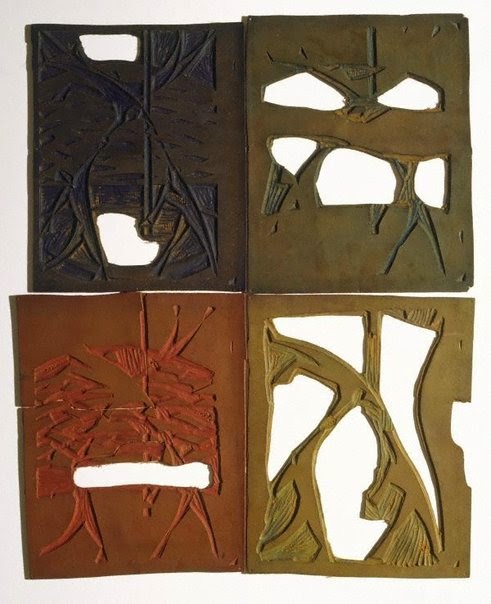 |
| Left-right: Godwin Bradbeer and Shane Jones at Melbourne Airport |
We are not long back from four eventful days in Adelaide, South Australia. My Uncle Robin, with whom we stayed, had been urging us to fly over for the exhibition Dorrit Black: Unseen Forces, at the Art Gallery of South Australia. Due to unusually heavy fog, our Melbourne departure was delayed and we grumpily prepared ourselves for a long wait, trying hard not to think of how much this would cut into our precious time in Adelaide. It was at this point we discovered fellow artist Godwin Bradbeer (a friend and former colleague from my teaching days in the RMIT University Drawing Department) was also Adelaide-bound. We hadn't seen him in ages and the extended waiting time (thankfully, in the end it was only an hour and a half) flew by as if t'were mere seconds.
At Adelaide Airport my uncle was patiently awaiting our arrival. Robin lives in the seaside suburb of
South Brighton, an area that has been a constant in my life. I’ve been coming here
since I was a child, when my late grandparents lived around the corner in Lewis
Street. (Their house has only recently been demolished). A long walk on the
beach a block from Uncle Robin’s house is a prerequisite and always opens a
floodgate of memories.
 |
| Shane on Brighton Beach |
 |
| Robin and Shane on Brighton Pier |
The following morning Shane and I set off for the Art Gallery of South Australia and the exhibition we'd flown all this way to see.
Adelaide-born Dorrit Black (23 December 1891 - 13 September 1951) is one of the finest modernist painters and printmakers this country has produced, a key figure often unjustly overlooked in the history of Australian art. She was one of the artists whose distinctive prints I studied when teaching myself lino cutting in the early 1980s, so I was very much aware of her work. But until seeing this stunning exhibition, which comprised over 200 works, I had no idea of its extraordinary range and scope. Its evolution continued right up to her untimely death in a car accident in 1951. Based on the evidence of her last paintings, Shane and I are convinced that still finer work would have been ahead of her.
 |
|
Dorrit Black, Mirmande,
c.1928, Mirmande, France, oil on canvas, 60 x 73.8 cm, Elder Bequest Fund 1940.
Art Gallery of South Australia, Adelaide.
|
 |
|
Dorrit Black The
Bridge, 1930, Sydney, oil on canvas on board, 60.0 x 81.0 cm, Bequest of
the artist, 1951.
Art Gallery of South Australia, Adelaide.
|
 |
|
Dorrit
Black, Music, 1927/8, colour linocut,
London or Paris.
|
 |
|
Dorrit Black, The
acrobats, 1927-1928, colour linocut, printed in colour from
four blocks on
thin cream paper, 25.1 x 17.7 cm image; 25.8 x 23.8 cm sheet (irreg.)
editon no: 7/50
|
 |
|
Four linoblocks for The
acrobats. Lino blocks mounted on hardboard with Perspex,
25.4 x 21.6 x 0.3
cm each block, collection Art Gallery of NSW,
gift of the artist's sister, Mrs Helen Finlayson 1967
|
 |
|
Dorrit Black, The mountain lake, c. 1935, colour linocut on Japanese paper,
29.7 x 20.7 cm (comp.) 35.6 x 26.5 cm
irreg. (sheet). Edition 6/50
|
 |
|
Dorrit
Black, Argentina (The Spanish dancer)
c. 1929, colour linocut,
18.8 x 16.0 cm (image)
23.9 x 21.2 cm irreg. (sheet)
|
Such is the shameful state of neglect of
this artist I found it difficult to find images to download here. The Art
Gallery of SA has published an excellent, extensive catalogue, which I understand will soon be viewable online. Once it becomes available, I’ll add a link
to this post. Meanwhile, you can
read a little about the Dorrit Black exhibition HERE and about Dorrit
Black herself HERE.
